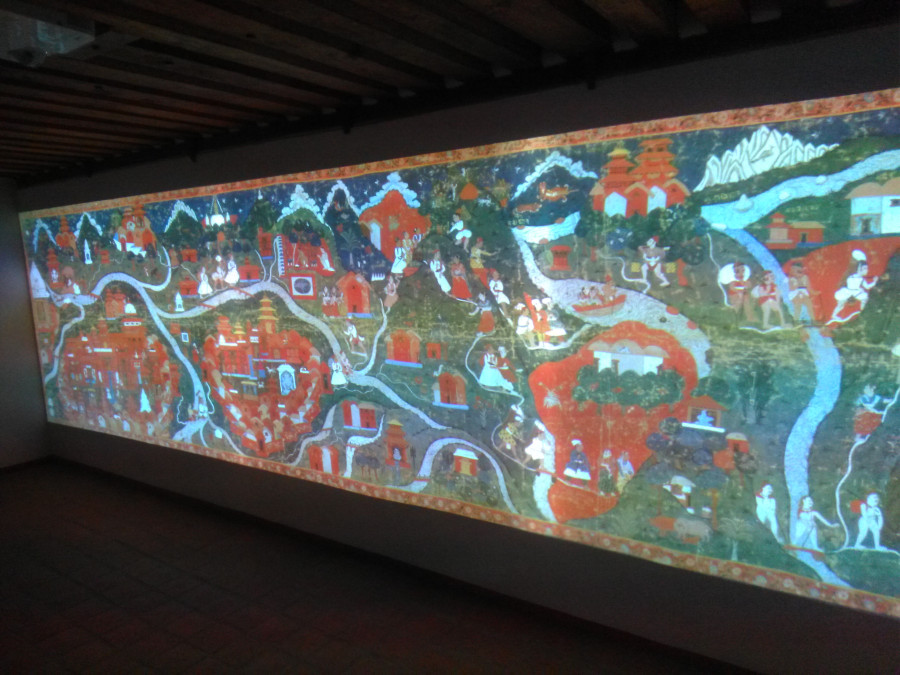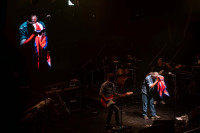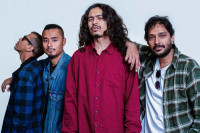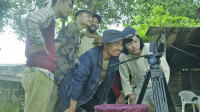Entertainment
Copy of paubha at Patan Museum while original is in the US
Surrounded by greens and blues is a white, snaky trail interspersed with human figures intricately detailed in their dress and manner. Around them are trees, temples, and monuments, all architecturally sound for the day and age.
Timothy Aryal
Surrounded by greens and blues is a white, snaky trail interspersed with human figures intricately detailed in their dress and manner. Around them are trees, temples, and monuments, all architecturally sound for the day and age. This 17th or early 18th century paubha painting depicts the trail from Patan to Kathmandu to Gosainkunda. Unfortunately, even though this painting was made in the Kathmandu Valley, what the Valley’s residents can see is its digital recreation, currently on display at the recently-opened audio-visual room of the Patan Museum at Mulchowk.
Titled ‘Pilgrimage to Gosaikund’, the paubha features several pilgrims—the white human figures—en route to the Gosainkunda Lake from Patan and includes the major sites encountered on the way. It also depicts all the three Durbar Squares of the Kathmandu Valley, with prominent heritage sites, including the Sundarichowk and Mulchowk in Patan and the Pashupatinath temple, say experts. The tradition of travelling to the lake has been in practice since centuries and continues even today.
“The painting—literally a map of the route from Patan to Kathmandu to Gosaikunda—is an extraordinary record of the culture at that time—depicting the landscape, architecture, dress and society,” reads a note embossed in the digital copy of the painting. The painting also includes a depiction of the celebration of the Rato Matsyendranath Jatra.
Renowned paubha artist Lok Chitrakar estimates the painting to have been made during the reign of Pratap Malla, which was in the mid-to-late 17th century. “Back then, art and life were inextricably linked,” said Chitrakar. “In a way, art itself was life. It definitely gives a glimpse of the society back then.”
The original paubha, measuring 83.8 x 435.6 cm, is currently housed at the Philadelphia Museum of Art in the US. While the museum’s official website mentions that the painting was “purchased with the Stella Kramrisch Fund” in 2000, it doesn’t state how this centuries old piece of heritage art was acquired.
Suresh Lakhe, director of the Patan Museum, said that there is no knowledge about when and from where the artwork was sold and taken abroad, but he estimates it must have been in the 1950s or 60s.
The painting was first brought to attention about a decade ago by Niels Gutschow, a German national familiar with Nepali painting when visiting the Philadelphia Museum. “It’s been over six years that we have personally tried to get government officials to bring the monumental painting back to Nepal,” said Rohit Ranjitkar, an architect and director of the Kathmandu Valley Preservation Trust. “However, it’s impossible to bring pieces like this back home through personal effort. We have repeatedly informed government officials, but since the government has not done anything significant we brought a high-quality visual. It’s a significant work and is as relevant today as it was at the time it was conceived.”
“This is just one example,” said Chitrakar. “There are many works like this out of the country and it’s hard to bring them back. They only come to light when someone writes about it.”
Rabindra Puri, a heritage conservationist, said that over 80 percent of Nepal’s artworks are still abroad. While many idols and statues have been returned over the past few decades, there’s been little conversation about Nepal’s stolen paintings.
The Patan Museum is currently working with Department of Archaeology to bring back the paintings and other stolen Nepali art, said Lakhe. Processes to return lost idols and paintings are currently underway, with several successes in the last decade, Ram Bahadur Kunwar, spokesperson of the Department of Archaeology, told the Post. However, he knew nothing of the paubha painting in question.
Pilgrimage to Gosaikund is currently on show in the audio-visual room at Mulchowk, Patan Museum.




 7.12°C Kathmandu
7.12°C Kathmandu










